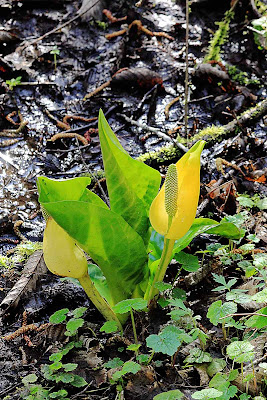When weather or time doesn’t permit a trip to the
Gorge, we look for wildflowers inside of Portland. One place we've found two early spring species is Tryon Creek State Natural Area. It is a 600 acre park
straddling the Tryon Creek on Portland’s southwest side. In March we look for
Trillium and Skunk Cabbage there.
 |
|
Lysichiton americanus, Western Skunk Cabbage or Swamp lantern.
|
You can see why this plant is called “Swamp
lantern”: the yellow petal seems to glow. It
It flowers early in the spring when only the
flowers are visible above the mud. The stems remain buried below the surface of
the soil with the leaves emerging later. They are a hardy plant to withstand
Spring cold snaps.
In the Midwest we knew the Eastern skunk cabbage,which blooms in late winter or early spring and can withstand ice and snow.
 |
| Symplocarpus foetidus, Eastern skunk cabbage |
This plant had emerged in early
February in suburban Chicago and then was covered with snow.
At Tryon, Skunk Cabbage is located in a swampy area near the
Beaver Bridge. Look for perennially muddy places - that’s where you'll most likely find it. Northwest Indians used
the leaves for “Indian Wax Paper” to line baskets, etc. It was rarely eaten
except as famine food.
Nearby we spot the bright pink of another early bloomer, the Salmonberry. Their bright orange berries are one of the earliest berries to ripen.
 | ||
| Rubus spectabilis, Salmonberry |
But Tryon Creek is best known for its Trillium.
 |
| Trillium ovatum, Western Trillium |
The three white petals begin to light up the forest floor in late March.
They will peak here about the first week of April, when an annual “Trillium Fest”
is held to celebrate them.
As a photographer, I find these plants particularly challenging. The white petals seem to catch the light extremely
well. Exposing the picture for the average between light and dark will result
in the whites being “blown out” (over exposed). The petals have fine hair-like
veins running through them. When the petal is properly exposed those veins are
visible. So I expose for the white and let the background remain somewhat dark.
A second challenge with Trillium is their relatively large
size. That means, if I want to get close enough to see the details of the
petals, there will be a large distance from the front to the back of the
picture. To compensate for that it is necessary to create a large depth of
field by closing the lens to a very small f-stop. That in-turn means a long
exposure. Hence the need for a tripod (and hope there is no wind).
The picture below shows a Trillium lit from behind by a splinter
of sunlight. Part of the petals are brightly lit and part are in the shade.
By exposing for the white, the background is dark. And so I experimented with HDR - High Dynamic Range. The picture below shows the background as well
as the white petals.
HDR is a technique
using multiple exposures of one scene blended together to produce a more balanced
exposure. It is controversial among nature photography critics who say “this is
not reality”. It is not “truth in
photography”.
I’ll have more to say about HDR and blended photography in
future blogs.
Copyright 2013 Tom Nelson
All Rights Reserved
Please ask before you use my photos





No comments:
Post a Comment